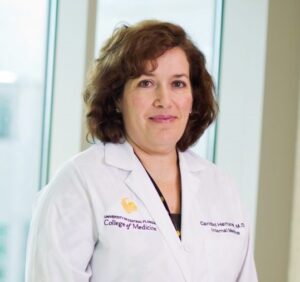Making a Difference in Hispanic Healthcare Disparities

[ad_1]
Hispanics continue to face severe health disparities and UCF’s College of Medicine can play a role in easing those challenges, says Caridad Hernandez, chair of medical education, at a recent Hispanic Heritage Month event.
A 2021 study found that 34% of nonelderly Hispanic residents in the United States do not have a physician — compared to 18% of African Americans and 16% of Caucasians. This lack of access to care, along with poverty, language challenges, food insecurity and other societal factors — called the social determinants of health — lead to higher rates of diseases including diabetes, heart disease, HIV/AIDS and cancer for Hispanics.
“Where you live – your zip code — is the most important determinant of your health, regardless of race or ethnicity,” says Caridad Hernandez, professor in the College of Medicine. “Let’s look at ways that we, as educators, researchers and clinicians, can make a difference.”

One solution on the horizon is a new mobile healthcare clinic — a collaboration of the UCF Academic Health Sciences Center (AHSC). The 38-foot van is expected to launch in June 2024, with participation from faculty and students of the AHSC’s three colleges: Health Professions and Sciences, Medicine and Nursing. It will provide preventative and screening services, with the goal of improving chronic disease management and unnecessary ER visits. By providing care where patients are, Hernandez says the mobile clinic will allow providers to be more engaged in the community and learn first-hand the community’s needs. The mobile clinic will schedule visits in poverty hot-spots across Central Florida, including Apopka, East Orlando, Kissimmee, Parramore and St. Cloud.
In 2003, medical experts across the nation produced a book titled Unequal Treatment: Confronting Racial and Ethnic Disparities in Health Care. Twenty years later, while some progress has been made, Hernandez says that these disparities continue and have worsened due to COVID-19. The coronavirus pandemic showed once again that underserved and minority populations became seriously ill and died from COVID-19 more than their Caucasian counterparts.
Disparities in the Hispanic community come as that population grows throughout the state and nation. According to the U.S. Census, 63.7 million Hispanics now live in the U.S., accounting for 19% of the population. Hispanics make up 27.1% of the population in Florida, 32% of the population in Orange County and 55% in Osceola County. Many of Osceola County’s Hispanics — 41% — are from Puerto Rico, relocating to the U.S. after Hurricane Maria in 2017. In addition to other social determinants of health, many of these families face displacement issues and trauma from the hurricane, Hernandez says.
As the College of Medicine and the healthcare industry look at addressing healthcare disparities for Hispanics, Hernandez and Deborah German, UCF’s vice president for health affairs and dean, have suggested examining ways to diversify people entering medicine. For example, as technology helps improve care and health monitoring, medical schools might consider admitting more engineers who can help create new, more accessible delivery systems. And increasing the numbers of bilingual medical students — in languages such as Spanish and Portuguese — will create more doctors who can communicate with Hispanic patients in their native language.
Hernandez shares her personal journey through medicine as an illustration.
She arrived in the United States as a Cuban refugee at the age of 3. Her parents were farmers in Cuba and had little advanced education. Her mother worked as a seamstress in America. Her family only spoke Spanish in their home and Hernandez was their interpreter for all of their medical appointments.
“I didn’t end up here by accident,” she says of her life’s work.
[ad_2]
Source link
